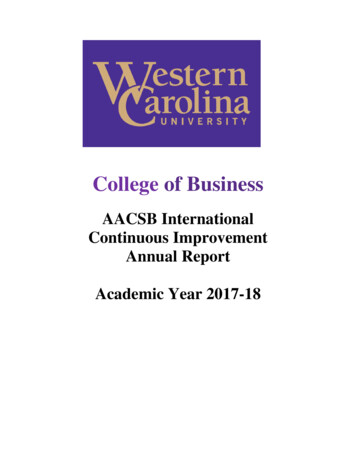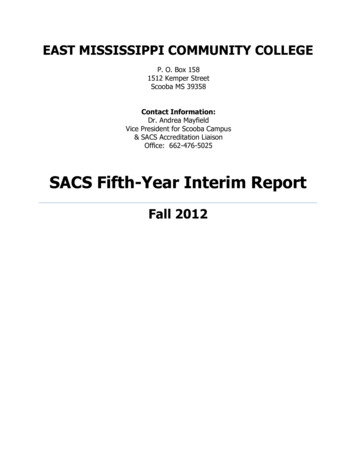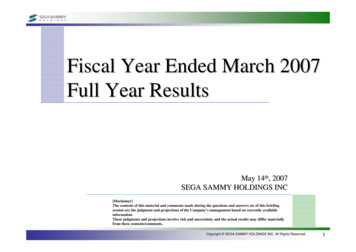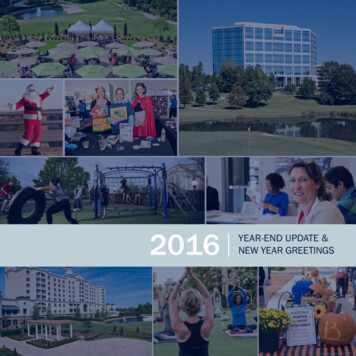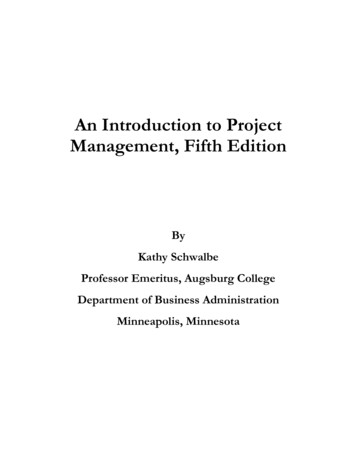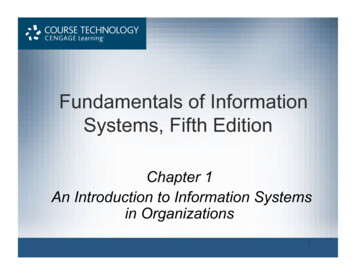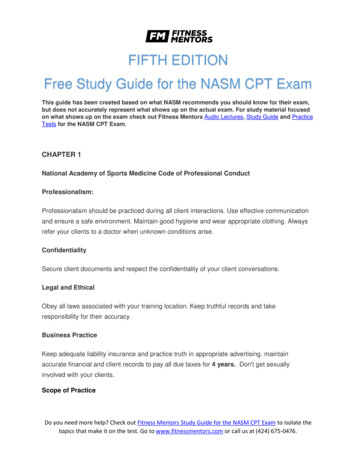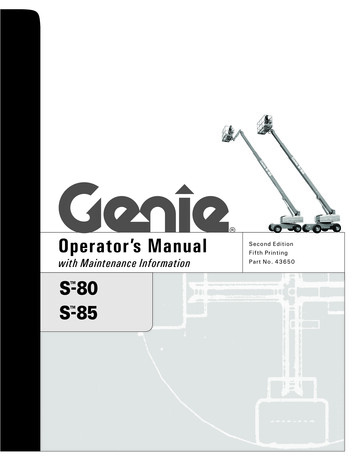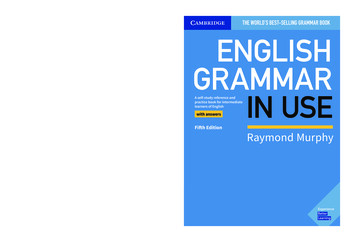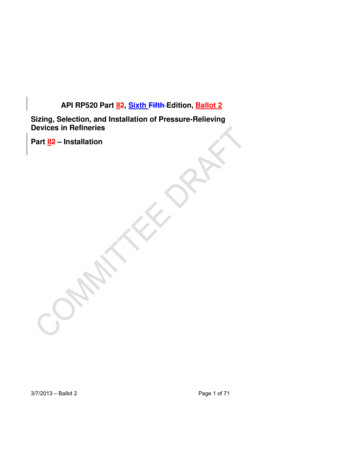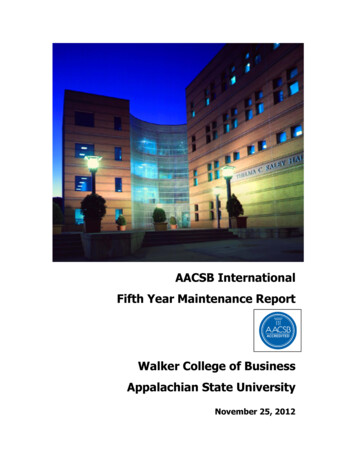
Transcription
AACSB InternationalFifth Year Maintenance ReportWalker College of BusinessAppalachian State UniversityNovember 25, 2012
Table of ContentsPage1. Situational Analysis . . . . . . . . . . . . . . . . . . . . . . . . . . . . . . . . . . . . . . . . . . . . . . . . . . . . . .History of Appalachian State University (ASU) . . . . . . . . . . . . . . . . . . . . . . . . . . . . . . . .History of the Walker College of Business (WCOB). . . . . . . . . . . . . . . . . . . . . . . . . . . . .Relative Advantages for the Walker College of Business. . . . . . . . . . . . . . . . . . . . . . . . .Relative Challenges for the Walker College of Business . . . . . . . . . . . . . . . . . . . . . . . . .Opportunities for Enhancing Degree Offerings in the Walker College of Business. . . . .111245Scope of Accreditation . . . . . . . . . . . . . . . . . . . . . . . . . . . . . . . . . . . . . . . . . . . . . . . . . . .52. Progress Update on Concerns from Previous Review. . . . . . . . . . . . . . . . . . . . . . . . . . . . .63. Strategic Management. . . . . . . . . . . . . . . . . . . . . . . . . . . . . . . . . . . . . . . . . . . . . . . . . . . . .3.A. Mission Statement and Summary of Strategic Plan or Framework . . . . . . . . . . . . .3.B. Strategic Management Planning Process and Outcomes . . . . . . . . . . . . . . . . . . . . .Summary of Key Continuous Improvement Achievements for 2007-2012 . . . . . . .3.C. Financial Strategies . . . . . . . . . . . . . . . . . . . . . . . . . . . . . . . . . . . . . . . . . . . . . . . . .3.D. New Degree Programs. . . . . . . . . . . . . . . . . . . . . . . . . . . . . . . . . . . . . . . . . . . . . . .77101121243.E. Intellectual Contributions . . . . . . . . . . . . . . . . . . . . . . . . . . . . . . . . . . . . . . . . . . . . .244. Participants . . . . . . . . . . . . . . . . . . . . . . . . . . . . . . . . . . . . . . . . . . . . . . . . . . . . . . . . . . . . .4.A. Students . . . . . . . . . . . . . . . . . . . . . . . . . . . . . . . . . . . . . . . . . . . . . . . . . . . . . . . . . .4.B. Faculty. . . . . . . . . . . . . . . . . . . . . . . . . . . . . . . . . . . . . . . . . . . . . . . . . . . . . . . . . . .2525285. Assurance of Learning. . . . . . . . . . . . . . . . . . . . . . . . . . . . . . . . . . . . . . . . . . . . . . . . . . . . .5.A. Overview. . . . . . . . . . . . . . . . . . . . . . . . . . . . . . . . . . . . . . . . . . . . . . . . . . . . . . . . . .5.B. BSBA Degree Program . . . . . . . . . . . . . . . . . . . . . . . . . . . . . . . . . . . . . . . . . . . . . .5.B.I. BSBA Degree Program Learning Goals . . . . . . . . . . . . . . . . . . . . . . . . . .343436365.B.II. BSBA Degree Program – Summary of Current AoL Approach . . . . . . . . .5.B.III. BSBA Degree Program “Closing the Loop” Activities. . . . . . . . . . . . . . . .5.C. MBA Degree Program – Assurance of Learning . . . . . . . . . . . . . . . . . . . . . . . . . . .5.C.I. MBA Degree Program Learning Goals . . . . . . . . . . . . . . . . . . . . . . . . . . . .5.C.II. MBA Degree Program – Summary of Current AoL Approach . . . . . . . . . .5.C.III. MBA Degree Program “Closing the Loop” Activities . . . . . . . . . . . . . . . .5.D. MS in Accounting Degree Program – Assurance of Learning . . . . . . . . . . . . . . . . .5.D.I. MS in Accounting Degree Program Learning Goals . . . . . . . . . . . . . . . . . .5.D.II. MS in Accounting Degree Program – Summary of Current AoL Approach3738414142434545465.D.III. MS in Accounting Program “Closing the Loop” Activities. . . . . . . . . . . . .46
6. Other Material: Points of Pride . . . . . . . . . . . . . . . . . . . . . . . . . . . . . . . . . . . . . . . . . . . . . .48Appendix A . . . . . . . . . . . . . . . . . . . . . . . . . . . . . . . . . . . . . . . . . . . . . . . . . . . . . . . . . . . . . . .Table 2-1 Five-Year Summary of Intellectual ContributionsA-1Appendix B . . . . . . . . . . . . . . . . . . . . . . . . . . . . . . . . . . . . . . . . . . . . . . . . . . . . . . . . . . . . . . .Table 2-2 Five-Year Summary of Peer Reviewed Journals and Number of Articles inEachB-1Appendix C . . . . . . . . . . . . . . . . . . . . . . . . . . . . . . . . . . . . . . . . . . . . . . . . . . . . . . . . . . . . . . .C-1Table 9-1 Summary of Faculty Sufficiency by Department Using Courses Taught,2011-12Appendix D . . . . . . . . . . . . . . . . . . . . . . . . . . . . . . . . . . . . . . . . . . . . . . . . . . . . . . . . . . . . . . .Table 10-1 Summary of Faculty Qualifications, Development Activities, andProfessional ResponsibilitiesD-1Appendix E . . . . . . . . . . . . . . . . . . . . . . . . . . . . . . . . . . . . . . . . . . . . . . . . . . . . . . . . . . . . . . .Table 10-2 Calculations Relative to Deployment of Qualified Faculty, 2011-12E-1Appendix F . . . . . . . . . . . . . . . . . . . . . . . . . . . . . . . . . . . . . . . . . . . . . . . . . . . . . . . . . . . . . . .F-1Part One – BSBA Assurance of Learning . . . . . . . . . . . . . . . . . . . . . . . . . . . . . . . . . . . . . F-2Part Two – MBA Assurance of Learning . . . . . . . . . . . . . . . . . . . . . . . . . . . . . . . . . . . . . F-13Part Three – MS in Accounting Assurance of Learning . . . . . . . . . . . . . . . . . . . . . . . . . . . F-24Appendix G . . . . . . . . . . . . . . . . . . . . . . . . . . . . . . . . . . . . . . . . . . . . . . . . . . . . . . . . . . . . . . . G-1Percentage of Peer-Reviewed Journal Articles By Contribution Type, 2007-2012Appendix H . . . . . . . . . . . . . . . . . . . . . . . . . . . . . . . . . . . . . . . . . . . . . . . . . . . . . . . . . . . . . . . . H-1Business Advisory Council (BAC) MembersBusiness Advisory Council (BAC) Members Emeriti
1. Situational AnalysisHistory of Appalachian State University (ASU)Founded in 1899 as Watauga Academy, Appalachian State University evolved into a stateteachers’ college, later broadened its mission to include the liberal arts, gained regionaluniversity status, and in 1971 became a part of the University of North Carolina system ofhigher education. Today, Appalachian is a growing public comprehensive master’sinstitution, offering more than 150 undergraduate and graduate majors and employing over870 full-time faculty members across seven colleges and schools. In 2011-12, Appalachianawarded 4,320 degrees, including 3,435 bachelor’s degrees, 798 master’s degrees, 44specialist degrees, 30 graduate certificates, and 13 doctorates. Throughout its growth, theUniversity has maintained a strong sense of community. It continues to provideeducational leadership and service to the state and region.Appalachian is located in the beautiful Blue Ridge Mountains of northwestern NorthCarolina in Boone, a destination town of approximately 17,000. Although historicallyserving mostly the western part of North Carolina, today the university draws itsenrollment of over 17,000 students from across the state and region. Approximately 90%of students are North Carolina residents, with the largest numbers coming from themetropolitan areas of Charlotte, Raleigh and Greensboro/Winston-Salem. Out-of-statestudents come from nearly every state in the nation and from a number of foreign countries,but the largest numbers come from the southeastern states of Virginia, Georgia, SouthCarolina, Florida, and Tennessee. Prospective students say their top reason for choosingAppalachian is the University’s strong academic reputation. Appalachian is also known forits value, appearing on Kiplinger’s Top 100 Best Values in Public Colleges list on arecurring basis.Although most of Appalachian’s students are of traditional college age and attend theUniversity’s main campus, the University seeks to serve a diverse student body. To meetthe needs of the region’s citizens and a wider population, Appalachian offers a variety ofdistance education degree programs at nearly 20 locations across Western North Carolina,as well as online.Appalachian has signature strengths in education, business, the arts, and undergraduateeducation, and emerging strengths in the core sciences, sustainability, and health-relatedprograms as well as research in renewable energy, environment, and health and humanperformance. The faculty are renowned for outstanding teaching and, increasingly, for bothbasic and applied research.History of the Walker College of Business (WCOB)The Walker College of Business had its beginnings as a department in the College of Fineand Applied Arts. In 1971, the College of Business was established as a separate academicunit within the University. In 1976, the College of Business received its initialaccreditation from AACSB, and was relocated to a new 55,000 square-foot four-storybuilding. At that time, both the College and the building were named for John A. Walker.1
John A. Walker was a businessman, philanthropist, and civic and community leader fromNorth Wilkesboro, NC. He had served as president and was one of the founding directorsof Lowe’s Companies. Walker provided the first major gift in the initial capital campaignfor the College. He maintained a long association with, and commitment to, the Collegeand served as the first chairperson of the College’s Business Advisory Council.A rapid growth in business students during the late 1970s and early 1980s led to the needfor expanded physical facilities. In 1985, funds for the initial design and planning of a newbuilding for the College were appropriated by the NC legislature. The 130,000 square-foot,four-story building was completed in the summer of 1990 and has been the home of theWalker College of Business since that time. The building was subsequently named RaleyHall, in honor of Thelma C. Raley, a prominent Florida citrus grower, Appalachian Stategraduate at age 80, and supporter of the Walker College of Business.Today, the Walker College of Business (WCOB) enrolls nearly 2,300 undergraduatestudents and over 120 graduate students, and has slightly more than 100 faculty members.The vast majority of students are of traditional college age, enrolled full-time in on-campusprograms, and taught primarily by full-time faculty members. Approximately 95% ofbusiness students are undergraduates.The WCOB houses six academic departments (Accounting; Computer InformationSystems; Economics; Finance, Banking and Insurance; Management; and Marketing) andoffers one undergraduate business degree, the Bachelor of Science in BusinessAdministration (BSBA), and two graduate business degrees, the Master of BusinessAdministration (MBA) and the Master of Science in Accounting (MSAcc).Within the BSBA undergraduate degree program, there are nine majors offered:Accounting, Computer Information Systems, Economics, Finance & Banking, Hospitality& Tourism Management, International Business, Management (with concentrations inEntrepreneurship, General Management, and Human Resources Management), Marketing,and Risk Management & Insurance.Six Centers and Institutes are housed within the Walker College of Business: the BB&TStudent Leadership Center, the Brantley Risk and Insurance Center (BRIC), the Center forEconomic Research and Policy Analysis (CERPA), the Transportation Insight Center forEntrepreneurship, the Center for Applied Research on Emerging Technologies (CARET),and the Martha Guy Summer Institute (MGSI).Relative Advantages for the Walker College of BusinessAACSB AccreditationThe Walker College of Business has been accredited by AACSB International since 1976.With less than 5% of the world's 13,000 business programs holding AACSB Accreditation,maintaining such accreditation provides a competitive advantage in attracting and retaininghigh quality faculty and students.2
Academic ReputationA solid academic reputation for Appalachian State University and the Walker College ofBusiness has been instrumental in attracting higher quality students and faculty over time.U.S. News and World Report consistently ranks Appalachian among its top 15 public andprivate southern universities (ranked #3 of the top public regional Universities in the Southin the 2013 guide), while The Princeton Review named Appalachian one of its “BestColleges in the Southeast” for 2012, and Forbes magazine named Appalachian one of“America’s Best College Buys” for 2012. The Walker College of Business was againincluded in The Princeton Review’s 2012 edition of Best Business Schools.High Quality FacultyThe Walker College of Business continues to maintain a full complement of highlyqualified faculty. As of Spring 2012, the college had 104 faculty FTEs, of which 102 werefull-time faculty members and 97 had terminal degrees. Faculty members are regularlyinvolved in a broad array of teaching, research, and service activities. Several facultymembers serve as academic journal editors, and a high percentage of faculty participate inboth academic and practitioner professional organizations. Ten faculty members holdEndowed Professorships: the Peacock, NC Bankers, Adams, Freeman, Insurance Agents ofNorth Carolina, Holshouser, Baker, Beroth, Daggett, and Guffey. In addition, two facultymembers hold Deans Club (non-endowed) Professorships. Numerous faculty membershave won university-wide teaching and service awards. Over the past five years, ourfaculty members have published over 500 peer reviewed journal articles, produced nearly1,000 other intellectual contributions, and generated over 4,000,000 in grant activity.Student Accessibility to FacultyDespite a marked increase in student credit hours (SCHs) generated in the WCOB over thelast five years (48,009 in 2007-08 to 54,576 in 2011-12), the WCOB has maintained arelatively small and constant average class size. In fact, 2011-12 had the smallest averageclass sizes out of the last five years (36 for the BSBA core and 31 for all BSBA courses).Interdisciplinary Academic ProgramsThe WCOB provides both graduate and undergraduate students with opportunities toengage in interdisciplinary course work and programs. Our MBA includes concentrationsin Sustainable Business and International Business. The Management Department offersan Interdisciplinary M.A. degree program with the Department of Psychology in IndustrialOrganizational Psychology and Human Resource Management. The EconomicsDepartment participates in the Environmental Politics and Policy Analysis Concentration inthe M.A. in Political Science. The Finance, Banking and Insurance Department offerscoursework in the Mathematical Sciences Department’s B.S. in Actuarial Sciences. TheWCOB offers undergraduate minors to non-business majors in Accounting, ComputerInformation Systems, Economics, Entrepreneurship, General Business, InternationalBusiness, Marketing, and Supply Chain Management. Finally, the WCOB participates inseveral of the cross-disciplinary themes of ASU’s General Education.3
Enrichment Opportunities and Programs for StudentsA variety of co-curricular opportunities and programs are offered by the college to enhancethe educational experience of students, including the Boyles Distinguished CEO LectureSeries, the Carole Moore McLeod Entrepreneur Summit, the College of Business HonorsProgram, the Bowden Student Managed Investment Fund, more than twenty student clubs,and many College of Business-sponsored study abroad experiences each year.Student Support ServicesUnique among the degree-granting colleges at Appalachian, the Walker College ofBusiness offers three in-house student support services areas: Academic Advising, CareerServices, and the BB&T Student Leadership Center, all of which are dedicated to fosteringstudents’ academic and professional development, leading them to success in the achievementof their collegiate and post-graduate goals. We have devoted significant private funds to thestudent support services areas over the last five years to bolster these efforts.Private FundingWith the solid support of many donors, including the College’s Business Advisory Council,the college has been able to secure pledges and actual dollars of more than 8 million overthe last five years.Relative Challenges for the Walker College of BusinessLack of Diversity in Student Body, Faculty, and StaffGiven the lack of diversity in the immediate geographic region in which the University islocated, it has been difficult to attract and retain those who would enhance our diversityprofile. However, the College and University have put programs in place to address thischallenge. More discussion is provided later in the body of this report.Faculty and Staff SupportFor the past three academic years (2009-10 through 2011-12), there were no state fundsavailable for equity or merit-based pay raises. A very modest across-the board increase of1.2% plus a merit pool for faculty equivalent to approximately 1.8% was allocated for thecurrent (2012-13) academic year. In light of the economic realities that we face, the Deanhas used private funds to supplement state funding for faculty research grants, facultyresearch expenses, and faculty travel grants.Physical SpaceRaley Hall, the building that currently houses the Walker College of Business, wasconstructed in the late 1980s. Although we are approaching full occupancy with our officespace, and our tiered classroom space is somewhat limited in functionality, we havesuccessfully used state funds to convert conference and work rooms into faculty and staff4
office space and private funds to convert computer labs into more functional meeting andCenter space. We have also used repair and renovation funds to significantly update theinterior look of the building, replacing carpeting, tile, and furniture, and repainting many ofour offices and classrooms.Changing Environment of Higher EducationThe changing environment of higher education is a concern we all face. The WCOB isresponding to this challenge. In Fall 2010, we launched a fully online BSBA degreeavailable through the University’s Distance Education program, at a reduced cost basedupon a lower fee structure. This is discussed more fully in Section 3.B., Goal 2.Opportunities for Enhancing Degree Offerings in the Walker College of Business The WCOB currently offers a minor in Supply Chain Management (SCM) forbusiness and non-business majors. We have held preliminary discussions with oursupply chain faculty, our Business Advisory Council and others about thepossibility of creating a major in SCM, based upon perceived demand by potentialemployers.The WCOB currently offers a concentration for management majors inEntrepreneurship (ENT) and a minor for non-business majors. We are holdingpreliminary discussions with our entrepreneurship faculty, our Business AdvisoryCouncil and others about the possibility of creating an ENT minor for businessmajors and/or an ENT major, based upon the strength and demand for the ENTprograms currently offered.The WCOB currently offers courses to graduate students pursuing ProfessionalScience Master’s (PSM) degrees at Appalachian. We see the opportunity forgrowth here, as the University adds new PSM degree programs and studentenrollment grows.We are seeing a growing number of students pursuing dual Master’s degrees withour MBA program. We anticipate this trend to continue over the next 5-year cycle.Scope of AccreditationAppalachian State University offers three degree programs in business that fall under thescope of this AACSB accreditation review. The degree programs and number of graduatesin the 2011-12 academic year are shown below.Degree ProgramsBSBABachelor of Science in Business AdministrationMBAMaster of Business AdministrationMSAccMaster of Science in AccountingTotal Graduates2011-12 Graduates56663396685
2. Progress Update on Concerns from Previous ReviewThere were two specific items noted in the “Identification of Areas that Must Be AddressedPrior to Next Maintenance Review” section of the 2007-08 Maintenance of Accreditationreview team report:1) Clarify the emphasis of intellectual contribution expectations for faculty members.2) Addre
History of Appalachian State University (ASU) Founded in 1899 as Watauga Academy, Appalachian State University evolved into a state teachers’ college, later broadened its mission to include the liberal arts, gained regional university status, and in 1971 became a part of the
